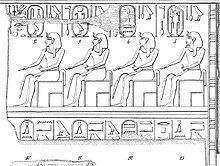Mentuhotep I.
| Name of Mentuhotep I. | ||||||||||||||
|---|---|---|---|---|---|---|---|---|---|---|---|---|---|---|
| Horus name |
Ḥr. (W) -tp [j] ˁ Horus ancestor |
|||||||||||||
| Proper name |
(Mentu hotep aa) Mnṯw ḥtp ˁ3 Month is content, the big one |
|||||||||||||
Mentuhotep I is the proper name of an ancient Egyptian king ( pharaoh ) of the 11th dynasty ( Middle Kingdom ), who lived from about 2137 to 2133 BC. BC ruled mainly in Upper Egypt .
supporting documents
Mentuhotep I (actually Mentuhotepaa , Montuhotep the Elder ) has not been documented with certainty on any contemporary monument and it has therefore even been assumed that it is a fictional ancestor of the 11th dynasty .
On a statue from the sanctuary of Heqaib on Elephantine , the upper part of which is missing today, he is described by a successor as ( jt-nTr.w ) father of the gods . By gods are meant the later kings; probably his two direct successors Antef I and Antef II , who are considered by some researchers to be his sons based on this inscription. This title in particular could indicate that Mentuhotep I was not a pharaoh after all. Such a title was usually only used by non-royal ancestors.
Possible origin
According to the royal table of Karnak , Mentuhotep I was possibly the successor of a Theban prince named Antef . However, this royal table is not arranged chronologically , so that this can only be taken as an indication .
Names and meanings
His birth name translates as " Month is satisfied", and his nickname on the statue in Elephantine "meri setjed nebet Abu" indicates that he was loved by the "mistress of Abu" (Elephantine). Since this statue was found on Elephantine, where this goddess was worshiped, this addition may only have been worn here. His throne name is unknown. However, this also applies to the three following kings of the 11th dynasty (Antef I-III; Beckerath, 1999). So it seems possible that he may never have accepted one. His Horus name ancestor was certainly given to him posthumously.
Regency
Possibly he was just a Theban prince, whose territory might extend from Koptos to the 1st cataract .
literature
- General
- Darrell D. Baker: The Encyclopedia of the Egyptian Pharaohs, Volume I: Predynastic to the Twentieth Dynasty (3300-1069 BC). Bannerstone Press, Oakville 2008 ISBN 978-0977409440 , pp. 222-223.
- Thomas Schneider : Lexicon of the Pharaohs . Albatros, Düsseldorf 2002, ISBN 3-491-96053-3 , p. 155.
- Peter A. Clayton: The Pharaohs. Bechtermünz, Augsburg 1995, ISBN 3-8289-0661-3 , pp. 68, 72ff.
- About the name
- Annales du Service des Antiquités de l´Egypt Le Caire. Volume 55, 1900, pp. 178ff.
- Jürgen von Beckerath : Handbook of the Egyptian king names. Deutscher Kunstverlag, Munich / Berlin 1984, ISBN 3-422-00832-2 , pp. 63, 193.
- Questions of detail
- Labib Habachi : Elephantine IV. The Sanctuary of Hequaib. 2 volumes In: Archaeological Publications. (AV) 33, Mainz 1985, Volume II, p. 109f .; No. 97 with plate 187–188.
- Labib Habachi: God's fathers and the role they played in the history of the First Intermediate Period. In: Annales du services des Antiquities de l'Egypte. (ASAE) Vol. 55, 1958, pp. 167-190.
- Elke Blumenthal : Journal for Egyptian language and antiquity. Volume 114, 1987, pp. 21f.
- Farouk Gomaá: Egypt during the First Intermediate Period (= supplements to the Tübingen Atlas of the Middle East. (BTAVO) Series B [Geisteswissenschaften] Volume 27) Wiesbaden 1980, pp. 136-138, 140-143, 146.
Individual evidence
- ↑ Writing the name after the statue from the Hekaib sanctuary
- ^ L. Habachi: The Sanctuary of Hequaib. Mainz 1985, for photos see: Volume II, plates 187–189.
- ^ Louise Gestermann: Continuity and change in politics and administration of the early Middle Kingdom in Egypt. Wiesbaden 1987 p. 26.
- ^ L. Habachi: God's fathers and the role they played in the history of the First Intermediate Period. In: ASAE Volume 55, p. 167ff.
- ↑ The name is only preserved on an old drawing by Prisse d'Avennes, see L. Habachi: God's fathers and the role they played in the history of the First Intermediate Period. In: ASAE Volume 55, Figure 4.
| predecessor | Office | successor |
|---|---|---|
| unsure |
King of Upper Egypt 11th Dynasty (beginning) |
Antef I. |
| personal data | |
|---|---|
| SURNAME | Mentuhotep I. |
| BRIEF DESCRIPTION | ancient Egyptian king of the 11th dynasty |
| DATE OF BIRTH | 22nd century BC Chr. |
| DATE OF DEATH | 22nd century BC Chr. |

